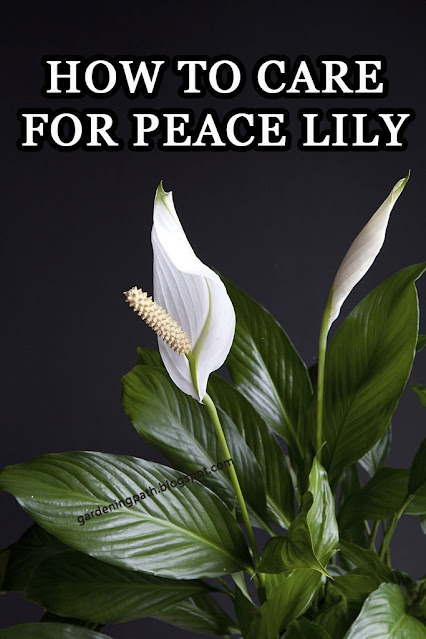How To Care For Peace Lily (Spathiphyllum)
Peace lilies are not only remarkable through the fact that they stay green all year round, but also because they don’t require too much care, making them great plants for beginners. Additionally, these plants look fabulous in any house and can match almost any interior design. Plus, are excellent air-purifying plants.
As always, to find out how to best care for a plant, you first need to know a few things about its origins. Therefore, let me provide you a little background about peace lilies.
Peace Lilies
Despite its name, the peace lily is not a member of the Liliaceae family but belongs to the family Araceae, in the genus of Spathiphyllum.
The peace lily is a perennial plant indigenous to the tropical regions of the Americas and southeastern Asia. In its natural habitat, this plant grows on the floor of the tropical forests, amongst the trees.
Many say that the name “peace lily” comes from its white blossoms that look like white flags of peace.
While the name “peace lily” is frequently used for a group of closely related and similar plants, there are more than 40 distinct species of peace lilies.
Unless you’re an expert or you are dealing with a species that has obvious particularities (such as the spathiphyllum domino, or spathiphyllum white streak), it’s pretty challenging to identify the exact variety of a peace lily plant.
I think mine is a spathiphyllum wallisii (although I’m not entirely sure).
As you can see, this variety of peace lily stands out through its dark green glossy leaves and the white, unusual flowers that arise amongst them.
Peace Lily Care
Now that you know a thing or two about peace lilies, it’s time to learn how to take care of these plants, as well as which are the best conditions for them to prosper.
Climate
As already mentioned, peace lilies are plants that originate from the tropical forests. This should already give you a clue about what climate these plants prefer.
Peace lily prefers a warm and humid environment. The best temperatures for this plant to grow are within 68-85°F (20-30°C) range.
While it tolerates heats, peace lily doesn’t tolerate cold very well. Any colder period of less than 40°F (5°C) will destroy the plant. Keep the plant inside, in a heated room, when the temperatures drop, and it should be fine.
Keep peace lilies away from air currents, air conditioning, and places where the temperature fluctuates frequently.
Even though these plants are usually grown as indoor-only plants and many recommend to keep them always inside, during the summer, I move the pot of my peace lily outside.
If you do that also with your plants, just be careful not to place them in full sun and water them more frequently. We’ll talk about the sun and light requirements of peace lilies below.
Sun & Light Requirements
In the wild, peace lilies grow on the tropical forest floor. Most of the time, trees cover the sky above them and do not allow too many sun rays to reach them directly. Consequently, peace lilies are plants that do not need too much light and sun to grow. That’s also one of the reasons why these make wonderful houseplants.
During the fall and winter, I keep my peace lily in a heated hallway that has many windows, therefore plenty of light manages to get inside. Yet, I place it in a spot where the sunlight never touches the plant directly, and so far, it seems to enjoy this environment.
Soil
In terms of pH, the soil should be slightly acidic to neutral. The best pH level is between 5.8 and 6.5.
Another aspect to consider when it comes to choosing a soil type for your peace lilies is the fact that these plants love humidity, but at the same time, they need good drainage and a well-aerated soil that doesn’t compact easily around their roots.
Proper soil is essential for a good growth of this plant. Hence, make sure that that the excess of water can effortlessly drain from the plant’s pot.
It would be best if you changed the substrate of these flowers every year to ensure that the soil doesn’t lose its properties. A peace lily will always enjoy fresh soil.
One interesting fact about peace lilies is that they can also survive by having their roots only submerged in water without any soil at all. Peace lilies are often grown in aquariums and are suitable plants for aquaponic systems.
Watering
As mentioned earlier, peace lily prefers humid but well-drained soils. This means that it’s best to try to keep its soil slightly moist all the time (however, make sure you do not overwater it).
The fact that these plants typically grow in semi-shade makes them not to require a very abundant watering. However, this may vary from one season to another.
I typically water my plant about once a week during the cold seasons and about 1-2 times a week during summer. If the top of the soil gets a bit dry, that’s a sign that you need to water the plant.
Being tropical plants, the peace lilies also love environments with high air humidity. To simulate the conditions found in its natural habitat, I like to spray its leaves with a water mister from time to time.
Another aspect that I think is worth mentioning about watering the peace lily is that this plant is more sensitive to chemicals in tap water. Such substances, like chlorine or chloramine customarily used to disinfect water, can harm these types of plants.
To reduce the levels of these chemical substances in the water, I usually leave the water bottle open for at least 24 hours after fill.
Fertilization
Peace lilies are not heavy feeders and do not require intensive fertilization. Still, just like any other plant, especially potted plants, for healthy development and to sustain blooming, peace lily plant needs fertilizer from time to time.
In terms of what is the best fertilizer for peace lilies, I would say that isn’t a specific one. A general 20-20-20 fertilizer (equal ratio of nitrogen, phosphorus, and potassium) should be able to offer this plant all the essential nutrients it needs.
Some people use slow-release fertilizers since these have extended action and will feed the plants for a long period. If you go that route, I recommend you trying these granules (link to Amazon).
I mostly prefer to use liquid or a water-soluble fertilizer for my potted flowers because the effects are more immediately, even though I have to apply the fertilizer more often. My lily seems to be very happy with this fertilizer (link to Amazon).
I usually fertilize my peace lily plant every 2 to 3 weeks. Depending on how your plant develops and the fertilizer of choice, you might want to do it more or less often.
If the tips of the leaves turn brown, this may be a sign of over-fertilization. If that happens, you should reduce the frequency of feeding your plant.
Flowering
Peace lilies will usually bloom during springtime but it’s not uncommon for the plant to produce new blooms throughout the year.
The flowers are formed only from a single modified leaf that grows behind a spadix. These flowers are white when they first appear and then gradually turn green.
Peace lily flowers can last for several months before they wilt.
Your peace lily is not flowering?
If you had a peace lily plant for some time but it hasn’t developed yet any white blooms, there can be one of the following reasons:
- Not enough light
- Your plant was grown from seeds
Even if peace lilies can thrive in low light that other plants would not be able to grow in, some people take this to extreme and place the plants in rooms with extremely little light.
Not only that these plants will not grow well in these kinds of spaces, but they also won’t produce flowers.
Propagation
There are two ways to propagate peace lilies:
- By Seeds
- By Division
Unlike other plants where you can grow new plants from cuttings, new peace lily plants can only be raised from seeds or by division.
The disadvantage of the first method is that when you grow a peace lily from seeds, it will take several years until the plant will develop flowers. So, unless you don’t mind waiting a few years to see the lily plant blooming for the first time, you should choose the second option.
The most popular and fastest way to propagate peace lilies while enjoying its flowers sooner is by division. This method implies separating a part of the plant from the main cluster.
Peace lilies have a rhizomatous root system. More precisely, they naturally multiply through a modified subterranean stem that forms out new roots and grows new shoots from its nodes.
These new plants grown from the shoots will have independent roots and can be safely detached from the parent plant without hurting it. Repot these new plants, and that’s how you propagate a peace lily by division.
You may also want to separate the clusters from time to time (when the plant becomes too bushy), even if you are not interested in growing more peace lily plants. That will give the main plant more space to develop its roots and make room for new growth.
Pests & Diseases
Just like most plants, peace lilies can catch diseases or can be targeted by various pests.
A common sign that your peace lily is unhappy is when the tips of its leaves turn brown. This can have multiple causes, like the lack of nutrients, overfertilization, too much or not enough water, inadequate temperature, and so on.
I started to notice these brown leaves tips on my peace lily when the temperature in the enclosed balcony where I was keeping it was arising too much throughout the day.
Final Word
Peace lilies are impressive houseplants. They have a magnificently natural look, can grow in relatively low light, give any room life, do not require too much fertilization, purify the air, and just about anyone can take care of them.




Comments
Post a Comment